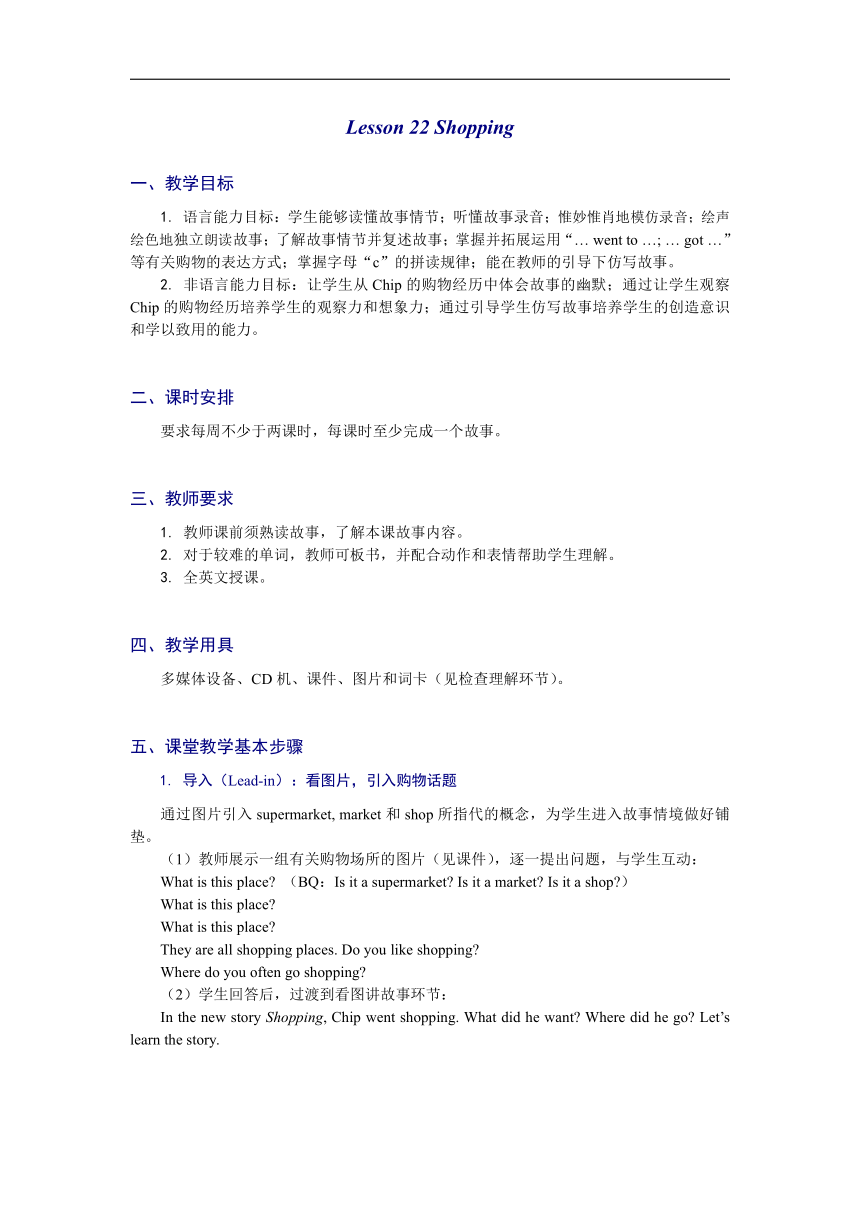
Lesson 22 Shopping 一、教学目标 1. 语言能力目标:学生能够读懂故事情节;听懂故事录音;惟妙惟肖地模仿录音;绘声绘色地独立朗读故事;了解故事情节并复述故事;掌握并拓展运用“… went to …; … got …”等有关购物的表达方式;掌握字母“c”的拼读规律;能在教师的引导下仿写故事。 2. 非语言能力目标:让学生从Chip的购物经历中体会故事的幽默;通过让学生观察Chip的购物经历培养学生的观察力和想象力;通过引导学生仿写故事培养学生的创造意识和学以致用的能力。 二、课时安排 要求每周不少于两课时,每课时至少完成一个故事。 三、教师要求 1. 教师课前须熟读故事,了解本课故事内容。 2. 对于较难的单词,教师可板书,并配合动作和表情帮助学生理解。 3. 全英文授课。 四、教学用具 多媒体设备、CD机、课件、图片和词卡(见检查理解环节)。 五、课堂教学基本步骤 1. 导入(Lead-in):看图片,引入购物话题 通过图片引入supermarket, market和shop所指代的概念,为学生进入故事情境做好铺垫。 (1)教师展示一组有关购物场所的图片(见课件),逐一提出问题,与学生互动: What is this place? (BQ:Is it a supermarket? Is it a market? Is it a shop?) What is this place? What is this place? They are all shopping places. Do you like shopping? Where do you often go shopping? (2)学生回答后,过渡到看图讲故事环节: In the new story Shopping, Chip went shopping. What did he want? Where did he go? Let’s learn the story. 2. 看图讲故事(Storytelling):理解故事情节,观察Chip的购物经历 教师利用课件逐幅播放故事图片,并用丰富的表情、生动的英文和适当的肢体语言给学生绘声绘色地讲故事,让学生观察Chip的购物初衷、购物经过和结果。 (Picture 1)Chip wanted some biscuits. This book was about how to make biscuits and cookies. (指向爸爸手中的书) What did Chip need to make biscuits? He needed flour, eggs and sugar. (指向图片中的相应物品) But there was no sugar. Chip wanted some sugar. What would he do? (Picture 2)He went to the supermarket. Did he get the sugar? No. What did he get? He got some crisps. (指向Chip手中的crisps) (Picture 3)Then he went to the shop. Did he get the sugar? No. What did he get? He got a comic. (Picture 4)Next, he went to the market. Did he get the sugar? No. He got a ball. Where did he go after that? (Picture 5)He went home. Could Chip make some biscuits now? No! He forgot the sugar. What might Chip say? Oh no! 教师要注意启发学生思考,每次提问之后稍作停顿,不要急于说出答案,先观察学生的反应,如学生仍回答困难,再进一步给出提示引导学生作答。 3. 听录音跟读(Listening and Imitating):听懂录音并模仿出标准的语音语调 听录音模仿时,录音是什么音什么调,就让学生模仿成什么音什么调,引导学生正确朗读“supermarket”,“crisps”等较难的单词。 (1)放录音,让学生完整地听一遍故事,整体输入,不需停顿。 (2)放录音,全班学生齐声模仿跟读2-3遍。要求学生在理解故事内容的基础上,逐句跟录音指读。鼓励学生大胆开口,读出戏剧化效果,读出感情。 (3)放录音,请几名学生以比赛的形式逐句模仿朗读,看谁模仿得更好。教师注意引导学生正确朗读“supermarket”,“crisps”等较难的单词。必要时,教师要做出示范。 4. 朗读故事(Reading Dramatically):读懂故事并学会绘声绘色地独立朗读故事 通过多种形式的朗读,让学生能够绘声绘色地独立朗读故事,培养 ... ...
~~ 您好,已阅读到文档的结尾了 ~~